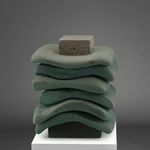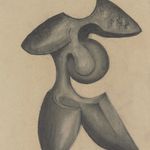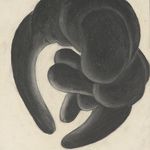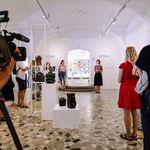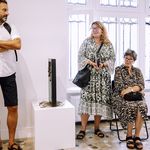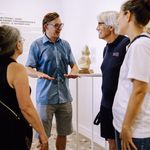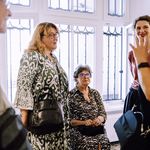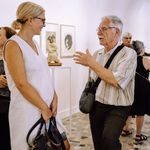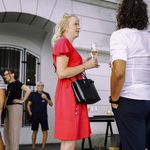Vojko Štuhec / Sculptor

Vojko Štuhec / Sculptor
UGM Kabinet, Strossmayerjeva 6
24 August—6 October 2024
opening: Saturday, 24 August 2024, 11:00
curator: Andreja Borin
The exhibition was initiated with the donation of sculptures and drawings by academic sculptor Vojko Štuhec to the Maribor Art Gallery from the artist's heirs, Alenka and Mojca Štuhec, the artist's wife and daughter. The donation consists of 33 sculptures, two sculptural drafts, and 150 paper drawings, sketches, and drafts. As there have only been a few sculptures by Vojko Štuhec from the Phytoliths and Figure series in the UGM Collection up to this point, the contribution is a significant addition to both the artist's body of work and the UGM's collection of sculptures. There is a collection of about 30 pieces on display. The exhibition highlights Vojko Štuhec's distinct periods of work, emphasises the relationship between sculpture and drawing, and showcases his many sculptural approaches. In addition, the exhibition provides an opportunity to present previously unseen works by the artist (such as Mobile, 1974, and various sketches).
Following his graduation from Ljubljana's Academy of Fine Arts, Vojko Štuhec focused mostly on creating organic forms throughout the first part of the 1970s, drawing inspiration from the reclining female body in the tradition of English sculptor Henry Moore. In order to add colour to sculpture, he patinated the siporex he used as his working material. While he experimented with kinetic-light objects and sculpto-paintings in line with the group Neo-constructivists in the 1970s, he did not pursue these ideas further. In the mature phase that followed, with the series Phytoliths (1975–1977) and Figure (1984–1985), he returned to organically conditioned sculpture. His studies concentrated on the principles of variation, multiplication, folding, and composition. He created numerous variations of the Phytoliths series, including three-dimensional and relief sculptures, small-scale sculptures, and large-scale public sculptures. The artist's travels throughout Scandinavia served as inspiration for the creation of the series, Odin Saga, in the mid-1990s. In this series, he experimented with abstract expression using wood, metal, and aluminium. Again, colour, composition, and the movement of the elements all played significant roles. In the works after 2000, the most frequent title is Composition or Folder. In his last completed series, Vojko Štuhec seems to have returned to his early interests. The artist did not use chiselling or modelling; he created the sculptures on the basis of a precise technical plan and revisited concepts, such as movement, application, multiplication, and variation.
Vojko Štuhec was always receptive to a variety of sculptural techniques: chiselling, carving, modelling, casting, patination, welding, etc. He was a restless seeker who did not remain committed to the fields he had already conquered. Most likely for this reason, he repeatedly decided to take up new themes, materials, and approaches. He has created both intimate-format and large-scale sculptures. The potential for public sculpture is present in many of the artist's sculptures; yet, not many public commissions or initiatives from the milieu were at hand, therefore the sculptor had to find his own creative challenges.
Vojko Štuhec's contributions have made a noticeable impact on Maribor and the wider Slovenian region. His work is part of the broader trend of 1970s–1980s Slovenian contemporary sculpture, which promoted the use of new expressive possibilities and the liberation of sculptural form. He made his name mostly as a sculptor of soft, rounded sculptures, which constituted the majority of his body of work, both in the public and the art world. On the other hand, new pieces were continuously being produced at the periphery of these series, suggesting a shift in the artist's focus and a diversity of interests.
Vojko Štuhec (1946–2018) received his degree in 1972 from the Academy of Fine Arts in Ljubljana, where he was taught by Boris Kalin, Drago Tršar, and Slavko Tihec. In 1974, he made Maribor his home. He worked as an art teacher at several secondary schools, and as a freelance artist since 1987. He participated actively in both the Maribor Fine Artists Society and the Slovenian Association of Fine Arts Societies. In addition to participating in multiple solo and group exhibitions, he has dedicated his time to public sculpture. Two of his public sculptures are to be found in Maribor: a fountain in the city park (1980) and a relief sculpture in the underpass beneath the railway bridge on Meljska cesta (1984). He also created individual public sculptures in the following locations: Štanjel in the Karst region (1968), student campus in Ljubljana (1970), Videm ob Ščavnici (1972), Ribnica na Pohorju (1980), Ruše (1980), and Radlje ob Dravi (1993). He worked on productions of Faust, Nabucco, Hamlet, The Csardas Princess, Carmen, and The Marriage of Figaro as a set designer with the Maribor Slovene National Theatre. The artist's works were the subject of a retrospective exhibition held in 1997 at the Maribor Art Gallery.
Exhibition setup: Andreja Borin, Simona Šuc
Translation: Ksenija Vidic
Layout: Matej Koren Studio
With gratitude to Alenka and Mojca Štuhec.
An extended text about the exhibition can be found here.





